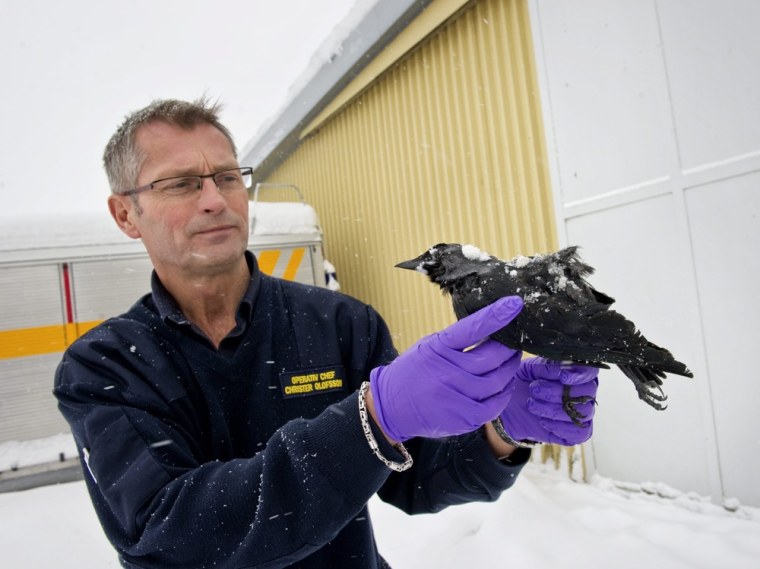It isn't easy being a bird.
First, New Year's Eve fireworks were blamed in central Arkansas for making thousands of blackbirds confused, crashing into homes, cars and each other. Then 300 miles to the south in Louisiana, power lines likely killed about 450 birds, littering a highway near Baton Rouge.
On Wednesday, Kentucky wildlife officials said several hundred grackles, red wing blackbirds, robins and starlings were found dead last week in the western part of the state.
It's almost certainly a coincidence the events happened within days of each other, Louisiana's state wildlife veterinarian Jim LaCour said Tuesday. "I haven't found anything to link the two at this point."
To add to the mystery, 50-100 jackdaws, a bird species in the crow family, fell dead in central Sweden late Tuesday night, English-language Swedish news website The Local reported Wednesday.
"We do not know what the cause is," Skovde police commander Tomas Ahlgren said. The birds fell in the city of Falkoping, which is southeast of Skovde.
Mass bird deaths aren't uncommon. The U.S. Geological Service's website listed about 90 mass deaths of birds and other wildlife from June through Dec. 12.
There were five deaths of at least 1,000 birds, with the largest near Houston, Minnesota, where parasite infestations killed about 4,000 water birds between Sept. 6 and Nov. 26.
Mystery remains
In Louisiana, the birds died sometime late Sunday or early Monday in the rural Pointe Coupee Parish community of Labarre, about 30 miles northwest of Baton Rouge.
The birds — a mixed flock of red-winged blackbirds, brown-headed cowbirds, grackles and starlings — may have hit a power line or vehicles in the dark, LaCour said. Two dozen of them had head, neck, beak or back injuries.
About 50 dead birds were near a power line 30 or 40 feet from Louisiana Highway 1. About a quarter-mile away, a second group of 400 or more stretched from the power line and across the highway, he said.
Dan Cristol, a biology professor and co-founder of the Institute for Integrative Bird Behavior Studies at the College of William & Mary, said the Louisiana birds may have been ill or startled from their roost, then hit the power line.
"They don't hit a power line for no reason," he said.
In Beebe, New Year's revelers spent the holiday weekend cleaning up dead red-winged blackbirds.
Some speculated that bad weather was to blame. Others said one confused bird could have led the group in a fatal plunge. A few spooked schoolkids guessed the birds committed mass suicide.
Officials acknowledged, though, they may never know exactly what caused the large number of deaths.
Cristol was skeptical of the fireworks theory, unless "somebody blew something into the roost, literally blowing the birds into the sky."
Wildlife officials in both Arkansas and Louisiana sent carcasses to researchers at the National Wildlife Health Center in Madison, Wis. and the University of Georgia.
LaCour said he didn't expect results for at least two or three weeks.
E. coli?
In 1999, several thousand grackles fell from the sky and staggered about before dying in north Louisiana. It took five months to get the diagnosis: an E. coli infection of the air sacs in their skulls.
"I hope things go faster than that," said Paul Slota, branch chief for the National Wildlife Health Center in Madison, Wisconsin. He said necropsies of the Arkansas birds began Tuesday afternoon.
"If it isn't strictly trauma, it may take more time to get results back," he said. "When nothing shows up, you run the tests longer and let it incubate longer."
The Arkansas Game and Fish Commission is also trying to determine what caused the deaths of up to 100,000 fish over a 20-mile stretch of the Arkansas River near a dam in Ozark, 125 miles west of Beebe. The fish were discovered on Dec. 30.
The commission expects results on the fish tests in probably a month. Disease may be the culprit, since almost all the fish were one species — bottom-feeding drum, the commission said.
Keith Stephens, a commission spokesman, said the events do not appear to be related. Both that section of the river and the air at the site of the bird deaths were tested for toxins, Stephens said.
As for the dead birds in Sweden, a county veterinarian would not speculate on the cause of their death, The Local reported. He was traveling to the site Wednesday to investigate.
"We will work quietly and methodically," he said.
Kentucky Department of Fish and Wildlife Resources spokesman Mark Marraccini says someone called police about the discovery in Kentucky, and they alerted state officials.
Marraccini says tests performed on the birds ruled out diseases or poisons. He said the deaths could have been caused by weather or another natural event.
